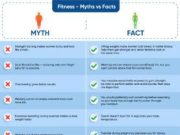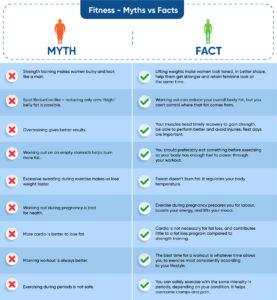In the world of fitness, strength training stands as a pillar of physical health, promising everything from enhanced muscle tone to improved mental well-being. Yet, despite its proven benefits, this discipline is often shrouded in a fog of misconceptions that can deter even the most enthusiastic of gym-goers. Enter the realm of myth-busting, where we sift through the sands of hearsay to uncover the truth about strength training. From the belief that lifting weights leads to bulkiness to the notion that cardio reigns supreme for weight loss, these pervasive myths can misguide and misinform. Join us as we unravel the top strength training myths, providing clarity and insight to empower your fitness journey with facts, not fiction.
Lifting Heavy Weights Wont Make You Bulky
It’s a common misconception that picking up a set of dumbbells will suddenly transform your physique into that of a professional bodybuilder. However, the truth is far more nuanced. Building significant muscle mass requires a precise combination of factors, including intense training, a caloric surplus, and often, a genetic predisposition. For most individuals, especially women, the fear of becoming “bulky” is largely unfounded. Instead, lifting heavy weights can lead to a more toned and defined appearance, enhancing strength and boosting metabolism without necessarily adding excessive bulk.
- Hormonal Differences: Women naturally produce less testosterone than men, making it challenging to gain large muscle mass.
- Caloric Intake: Without consuming a surplus of calories, significant muscle growth is unlikely.
- Training Intensity: Building large muscles requires specific training regimens, not just lifting heavy occasionally.
By incorporating heavy weights into your fitness routine, you’re more likely to experience improved muscle tone and increased strength, contributing to overall health and fitness without the undesired bulkiness.

Unpacking the Cardio vs. Strength Training Debate
When it comes to fitness, the choice between cardio and strength training often sparks lively debates. Each has its own set of fervent advocates, but the truth lies in understanding the unique benefits they offer. Cardio is frequently praised for its heart health benefits and calorie-burning prowess, but it often gets unfairly touted as the superior option for overall fitness. On the other hand, strength training is sometimes misunderstood or underestimated, especially with myths suggesting it leads to excessive bulk or isn’t effective for weight loss.
Let’s break down some common misconceptions about strength training in this context:
- Myth: Strength training is only for bodybuilders.
Reality: Strength training is versatile, enhancing muscle tone, improving metabolism, and increasing bone density for all fitness levels. - Myth: Cardio is better for fat loss.
Reality: While cardio burns calories during the workout, strength training boosts your resting metabolic rate, leading to long-term fat loss. - Myth: You can only do one or the other for optimal results.
Reality: A balanced fitness regimen that includes both cardio and strength training can maximize health benefits and enhance overall performance.
Ultimately, integrating both into your routine, tailored to your personal goals, is the key to unlocking a well-rounded fitness journey.
The Truth About Spot Reduction and Targeted Fat Loss
It’s a common belief that you can exercise a specific body part to lose fat in that area, but science tells a different story. The concept of spot reduction—the idea that working out a particular muscle group will lead to fat loss in that area—is a pervasive myth in the fitness world. While you can strengthen and build muscle in a targeted area, the loss of fat doesn’t work the same way. When you engage in physical activity, your body draws energy from fat stores throughout the body, not just from the muscles you’re working on. This means that doing endless crunches won’t necessarily give you a flat stomach, and countless leg lifts won’t make your thighs slimmer. The key to losing fat is a combination of a balanced diet and overall body workouts that increase your heart rate and burn calories.
Consider the following when planning your workouts:
- Incorporate a variety of exercises that target different muscle groups to promote balanced strength and endurance.
- Focus on compound movements like squats, deadlifts, and bench presses, which engage multiple muscle groups and burn more calories.
- Include cardio sessions to help create a calorie deficit, essential for fat loss.
- Prioritize consistency over intensity; regular workouts are more effective than sporadic high-intensity sessions.
Understanding the science behind fat loss can help set realistic goals and create a more effective workout plan that emphasizes overall health rather than chasing the elusive dream of targeted fat loss.

Why Rest Days Are Essential for Muscle Growth
In the pursuit of building muscle, many individuals mistakenly believe that more training leads to faster results. However, it’s crucial to understand that muscle growth doesn’t occur during your workouts but rather in the recovery period that follows. Rest days are not just a break from the gym; they are an essential component of an effective training regimen. During rest days, your body repairs and strengthens the muscle fibers that were broken down during exercise. This repair process, known as muscle protein synthesis, is what leads to muscle growth.
- Prevents Overtraining: Continuous exercise without sufficient rest can lead to overtraining, resulting in decreased performance and increased risk of injury.
- Boosts Performance: Taking time off allows your muscles to recover fully, enabling you to return to your workouts with improved strength and endurance.
- Balances Hormones: Rest days help regulate hormones such as cortisol and testosterone, which are critical for muscle growth and recovery.
By integrating regular rest days into your routine, you not only promote muscle growth but also ensure a sustainable and balanced approach to strength training.































